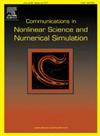不可扩展梁的竞争动力学:惯性与几何非线性
IF 3.8
2区 数学
Q1 MATHEMATICS, APPLIED
Communications in Nonlinear Science and Numerical Simulation
Pub Date : 2025-09-17
DOI:10.1016/j.cnsns.2025.109310
引用次数: 0
摘要
通过渐近分析的镜头,充分研究了具有弱约束端(即端质量+端弹簧/刚度)的不可扩展直梁的竞争动力学,涉及惯性非线性(有利于软化)和几何非线性(有利于硬化)。除了单调动力学(软化或硬化)外,本文还重点研究非单调动力学,即硬化/软化混合动力学(H/S)。结果表明,H/S过渡曲线(或分离矩阵)在确定上述单调和非单调两种不同的非线性动力学中起着关键作用,前者位于远离H/S过渡的位置,而后者位于H/S分离矩阵附近。在这两种情况下,发现不可扩展梁的主要非线性动力学关键取决于梁的端质量和端刚度。本文章由计算机程序翻译,如有差异,请以英文原文为准。
Competing dynamics of an inextensible beam: Inertial vs. geometric nonlinearities
Competing dynamics of an inextensible straight beam with a weakly constrained end (i.e., end mass+end spring/stiffness), involved with both inertial nonlinearity (favoring softening) and geometric nonlinearity (favoring hardening), is fully investigated through the lens of asymptotic analysis. Besides monotonic dynamics (either softening or hardening), the current paper focuses on non-monotonic dynamics i.e., mixed hardening/softening (H/S) dynamics. It turns out that the H/S transition curve (or separatrix) plays a key role in locating the above two distinct nonlinear dynamics, i.e., monotonic or non-monotonic one, with the former found away from H/S transition while the latter located in the vicinity of H/S separatrix. In both scenarios, the inextensible beam’s dominant nonlinear dynamics are found to critically depend on the beam’s end mass and end stiffness.
求助全文
通过发布文献求助,成功后即可免费获取论文全文。
去求助
来源期刊

Communications in Nonlinear Science and Numerical Simulation
MATHEMATICS, APPLIED-MATHEMATICS, INTERDISCIPLINARY APPLICATIONS
CiteScore
6.80
自引率
7.70%
发文量
378
审稿时长
78 days
期刊介绍:
The journal publishes original research findings on experimental observation, mathematical modeling, theoretical analysis and numerical simulation, for more accurate description, better prediction or novel application, of nonlinear phenomena in science and engineering. It offers a venue for researchers to make rapid exchange of ideas and techniques in nonlinear science and complexity.
The submission of manuscripts with cross-disciplinary approaches in nonlinear science and complexity is particularly encouraged.
Topics of interest:
Nonlinear differential or delay equations, Lie group analysis and asymptotic methods, Discontinuous systems, Fractals, Fractional calculus and dynamics, Nonlinear effects in quantum mechanics, Nonlinear stochastic processes, Experimental nonlinear science, Time-series and signal analysis, Computational methods and simulations in nonlinear science and engineering, Control of dynamical systems, Synchronization, Lyapunov analysis, High-dimensional chaos and turbulence, Chaos in Hamiltonian systems, Integrable systems and solitons, Collective behavior in many-body systems, Biological physics and networks, Nonlinear mechanical systems, Complex systems and complexity.
No length limitation for contributions is set, but only concisely written manuscripts are published. Brief papers are published on the basis of Rapid Communications. Discussions of previously published papers are welcome.
 求助内容:
求助内容: 应助结果提醒方式:
应助结果提醒方式:


